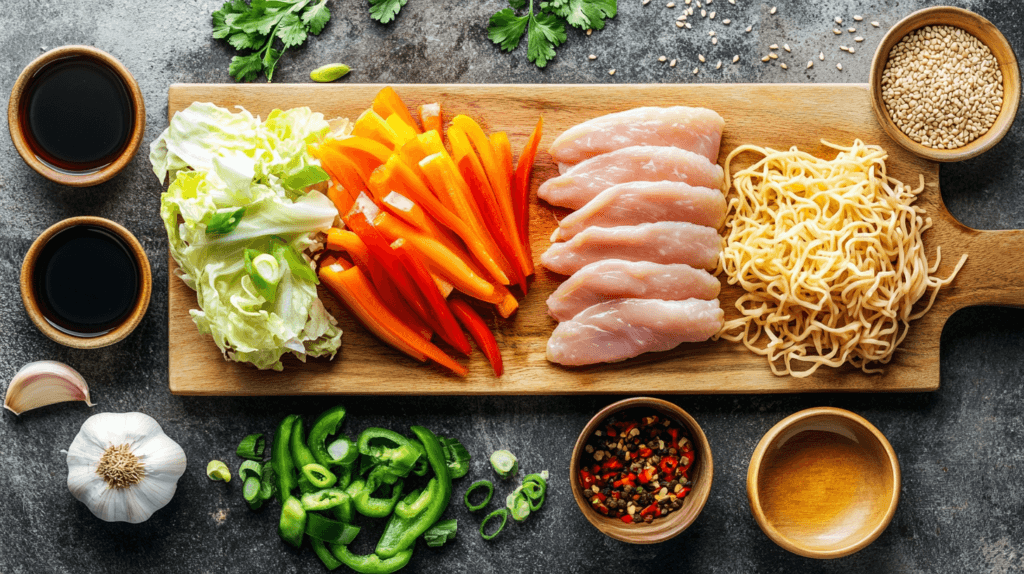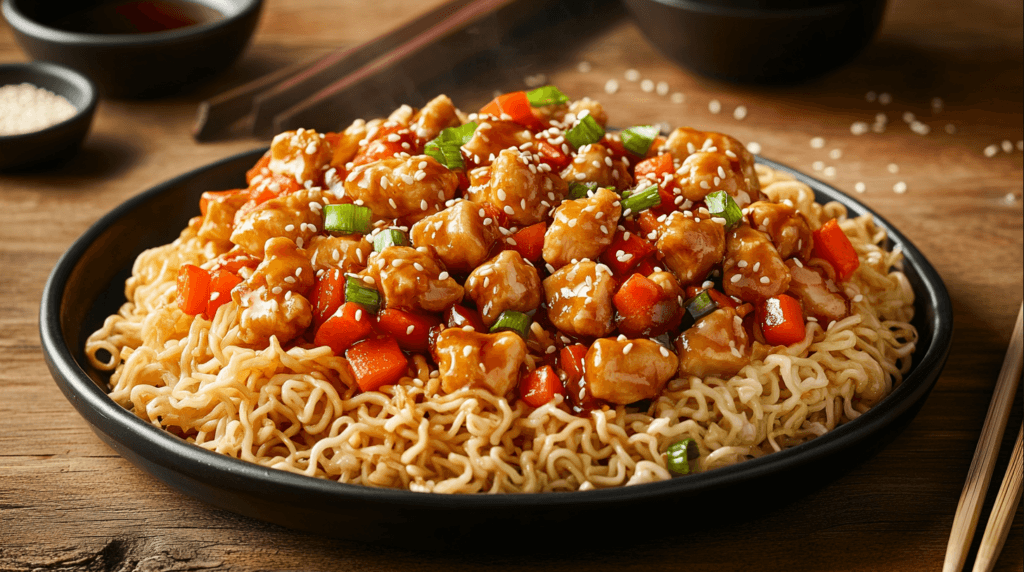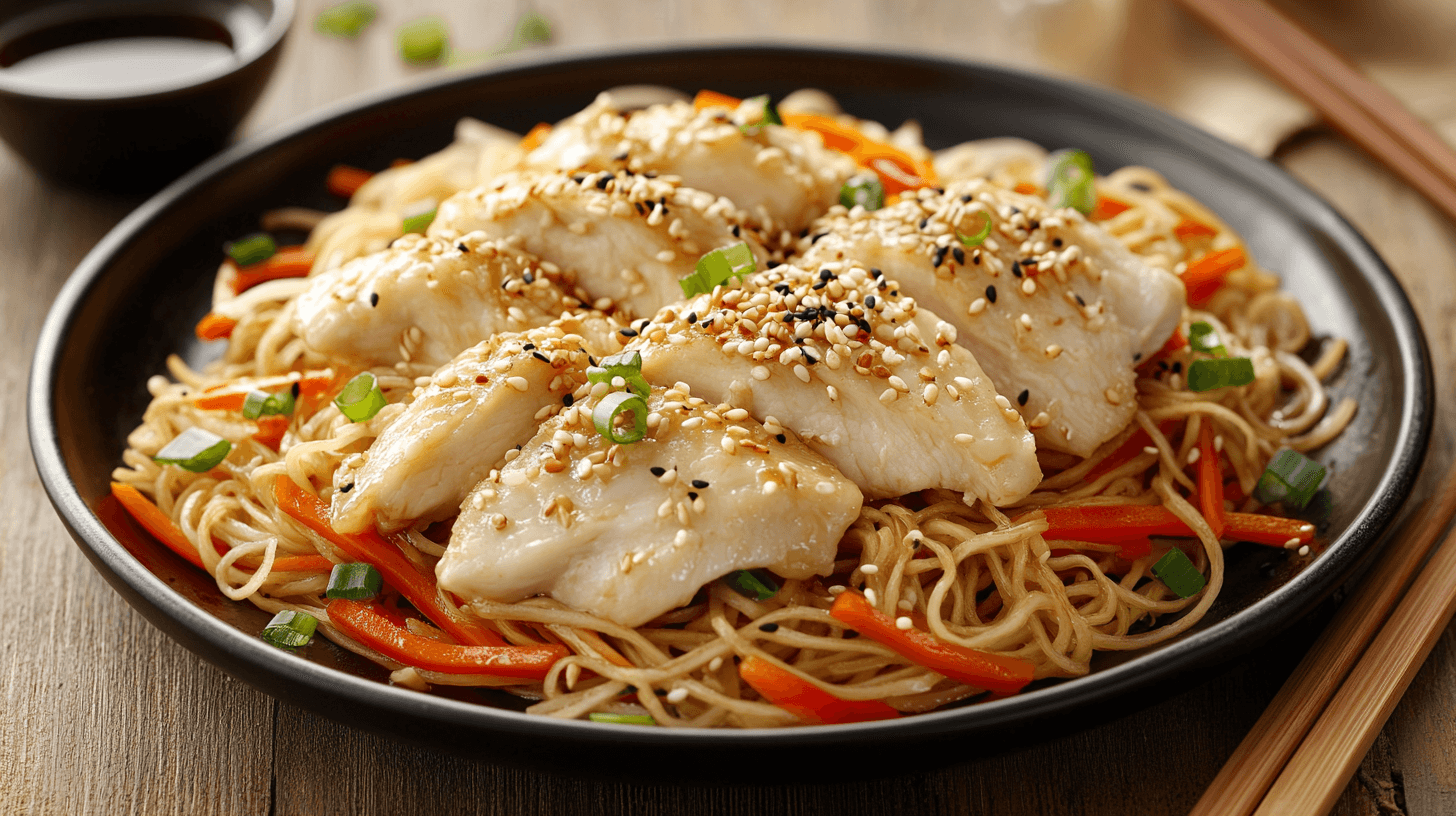Chicken Chow Mein is a flavorful and satisfying dish that has become a staple in Chinese restaurants around the world. Known for its tender chicken, crisp vegetables, and chewy noodles tossed in a savory sauce, this dish strikes the perfect balance of taste and texture. Originating in China, “Chow Mein” literally translates to “stir-fried noodles,” making it a versatile meal that can be tailored to suit various preferences and dietary needs. Whether you’re cooking for your family, hosting friends, or meal-prepping for the week, Chicken Chow Mein is an excellent choice that’s easy to prepare at home.
But what makes this dish so popular? Its versatility! You can adjust the ingredients to your taste or dietary restrictions, and it pairs wonderfully with other dishes or beverages. Plus, with a simple cooking process, it’s a perfect recipe even for beginners who want to dive into Chinese cuisine.
In this guide, we’ll break down everything you need to know about making an authentic Chicken Chow Mein. From selecting the right ingredients to mastering the stir-frying technique, you’ll find all the tips and tricks to elevate your cooking game. Let’s get started!
Ingredients
Making Chicken Chow Mein at home is straightforward, and the recipe uses ingredients that are readily available in most grocery stores. Below is a comprehensive list of what you’ll need for this delicious dish:
Essential Ingredients for Chicken Chow Mein
- Chicken:
- Use boneless, skinless chicken breast or thighs. Thighs are often preferred for their juiciness and tenderness.
- Quantity: About 2 cups, thinly sliced into strips.
- Noodles:
- Choose fresh chow mein noodles or dried egg noodles. For a healthier option, whole-wheat or gluten-free noodles can be used.
- Quantity: About 8 oz.
- Vegetables:
- Cabbage (green or Napa): 1 cup, thinly shredded.
- Carrots: 1 medium-sized, julienned or thinly sliced.
- Bell peppers (red, yellow, or green): 1, thinly sliced.
- Bean sprouts: 1 cup, optional but adds crunch.
- Green onions: 2 stalks, chopped.
- Sauces and Seasonings:
- Soy sauce: 3 tablespoons (regular or low-sodium).
- Oyster sauce: 2 tablespoons for a rich umami flavor.
- Sesame oil: 1 teaspoon for a nutty aroma.
- Hoisin sauce: 1 tablespoon for sweetness (optional).
- Garlic: 3 cloves, minced.
- Ginger: 1 teaspoon, finely grated.
- Black pepper: ½ teaspoon.
- Sugar: 1 teaspoon to balance the flavors.
- Cooking Oil:
- Use a neutral oil like vegetable, canola, or peanut oil for stir-frying.
- Quantity: 2 tablespoons.
Choosing the Right Noodles
- Fresh Chow Mein Noodles: Found in the refrigerated section of Asian grocery stores, these are pre-cooked and only require a quick stir-fry.
- Dried Egg Noodles: These need boiling before use but are more readily available in mainstream stores.
- Alternative Options: Rice noodles, soba noodles, or even spaghetti can work in a pinch.
Customizable Ingredients for Dietary Preferences
- Protein Options: Swap chicken with tofu, shrimp, or beef for variety.
- Vegetables: Broccoli, snap peas, or mushrooms can be added to enhance the dish.
- Low-Carb Option: Use spiralized zucchini or shirataki noodles instead of traditional noodles.

Equipment Needed
To prepare Chicken Chow Mein efficiently, you don’t need an elaborate kitchen setup. The following tools and equipment will help streamline the process and ensure the dish turns out perfect:
Basic Kitchen Tools
- Wok or Large Skillet:
- A wok is ideal for stir-frying as it distributes heat evenly and allows for quick cooking. If you don’t have a wok, a large, non-stick skillet works as well.
- Cutting Board and Sharp Knife:
- Essential for chopping vegetables, slicing chicken, and prepping ingredients.
- Mixing Bowls:
- Use medium-sized bowls to marinate the chicken and prepare the sauce.
- Pot for Boiling Noodles:
- If you’re using dried noodles, you’ll need a pot to boil and cook them.
- Tongs or Cooking Chopsticks:
- These are helpful for tossing the noodles, vegetables, and chicken together in the wok.
- Colander:
- For draining the noodles after boiling and rinsing vegetables.
- Grater or Microplane:
- Useful for grating fresh ginger or garlic.
Optional Equipment
- Mandoline Slicer:
- Speeds up the process of julienning vegetables like carrots and bell peppers.
- Garlic Press:
- For quickly mincing garlic if you prefer not to chop it by hand.
- Food Processor:
- If you want to shred large quantities of cabbage or other vegetables quickly.
Cleaning Tips
- Since stir-frying is a fast process, ensure all your tools and equipment are cleaned and prepped beforehand.
- Keep a damp cloth or sponge nearby to clean spills as you go.
With the equipment ready, you’re now set to start prepping the ingredients. Let’s move on to the Preparation Steps to get everything ready for cooking.
Preparation Steps
To achieve the perfect Chicken Chow Mein, proper preparation is key. This ensures that all ingredients are ready to be cooked quickly, as stir-frying is a fast-paced process. Follow these steps to prepare your ingredients efficiently:
1. Preparing the Chicken
- Slicing:
- Use a sharp knife to slice the chicken breast or thighs into thin, even strips. This ensures they cook evenly.
- Marinating:
- In a bowl, combine 1 tablespoon of soy sauce, 1 teaspoon of sesame oil, and ½ teaspoon of black pepper. Add the sliced chicken and mix until coated.
- Let the chicken marinate for 15–20 minutes while you prepare the other ingredients. This enhances flavor and tenderness.
2. Preparing the Vegetables
- Cabbage:
- Wash thoroughly and shred into thin strips using a knife or food processor.
- Carrots:
- Peel the carrot and cut into matchstick-sized strips (julienne). A mandoline slicer can make this easier.
- Bell Peppers:
- Remove the seeds and cut into thin slices. Use a mix of red, yellow, and green peppers for color variety.
- Green Onions:
- Trim the ends, then chop into 1-inch pieces.
- Bean Sprouts:
- Rinse under cold water and pat dry. Keep these separate to add at the end for maximum crunch.
3. Boiling and Draining the Noodles
- Boil the Noodles:
- If you’re using dried chow mein or egg noodles, cook them in a pot of boiling water for 3–4 minutes or according to package instructions. Do not overcook, as they will be stir-fried later.
- Drain and Rinse:
- Transfer the noodles to a colander, rinse with cold water to stop the cooking process, and toss with a teaspoon of oil to prevent sticking.
4. Preparing the Sauce
- In a small bowl, mix the following:
- 2 tablespoons soy sauce
- 2 tablespoons oyster sauce
- 1 tablespoon hoisin sauce (optional)
- 1 teaspoon sugar
- 1 teaspoon sesame oil
- 2 tablespoons water (or chicken stock for extra flavor).
- Stir until all ingredients are well combined and set aside.
5. Organizing Your Ingredients
- Arrange all your prepared ingredients (chicken, vegetables, noodles, and sauce) around your cooking area.
- Since stir-frying is fast, having everything prepped and within reach is crucial to avoid overcooking.
With all the ingredients prepped, you’re ready to dive into the cooking process and bring this flavorful dish to life.

Cooking Instructions
Now that all the ingredients are prepped, it’s time to cook your Chicken Chow Mein. Stir-frying is a quick and dynamic process, so follow these steps carefully to achieve the perfect balance of flavors and textures.
1: Heating the Wok
- Preheat:
- Place your wok or large skillet over medium-high heat. Let it heat up for about 1–2 minutes until it’s very hot. This is essential for proper stir-frying.
- Add Oil:
- Add 2 tablespoons of vegetable or peanut oil, and swirl it around to coat the bottom and sides of the wok.
2: Cooking the Chicken
- Stir-Fry the Chicken:
- Add the marinated chicken strips to the hot wok. Spread them out in a single layer and let them sear for about 1–2 minutes without stirring to develop a golden crust.
- Stir-fry for another 2–3 minutes until the chicken is fully cooked and no longer pink. Remove the chicken from the wok and set it aside.
3: Stir-Frying the Vegetables
- Add Garlic and Ginger:
- Lower the heat slightly, then add the minced garlic and grated ginger. Stir quickly for 20–30 seconds until fragrant.
- Add Vegetables:
- Add the shredded cabbage, carrots, and bell peppers. Stir-fry for 2–3 minutes until they soften slightly but still retain some crunch.
- Toss in the bean sprouts and green onions during the last 30 seconds of cooking.
4: Combining Noodles and Sauce
- Add Noodles:
- Increase the heat to high and add the boiled noodles to the wok. Use tongs or chopsticks to toss the noodles with the vegetables.
- Pour in the Sauce:
- Drizzle the prepared sauce evenly over the noodles. Toss everything together until the noodles are well coated, and the sauce is evenly distributed.
5: Adding the Chicken
- Return the cooked chicken to the wok. Stir everything together for 1–2 minutes to combine the flavors. Ensure all ingredients are heated through.
6: Final Touches
- Taste Test:
- Taste the noodles and adjust the seasoning if necessary. Add a splash of soy sauce for more saltiness or a pinch of sugar for balance.
- Optional Garnish:
- Sprinkle sesame seeds or chopped green onions on top for an extra layer of flavor and presentation.
Serving Suggestions
- Transfer the Chicken Chow Mein to a serving platter and enjoy it hot.
- Pair with side dishes like egg rolls or wonton soup for a complete meal.
With these simple steps, you’ve created a delicious, homemade Chicken Chow Mein that rivals any takeout option!
Variations of Chicken Chow Mein
Chicken Chow Mein is a highly adaptable dish, allowing you to customize it based on dietary preferences, available ingredients, or flavor profiles. Below are some popular variations and ideas to make this dish uniquely yours.
1. Classic vs. Crispy Chicken Chow Mein
- Classic Chicken Chow Mein:
- This version involves stir-frying boiled noodles with vegetables, chicken, and sauce until everything is well-combined and tender. It’s soft, flavorful, and the most common style served in restaurants.
- Crispy Chicken Chow Mein:
- For a crispy version, lightly pan-fry the boiled noodles in a thin layer of oil until golden and crispy on both sides. Serve the chicken, vegetables, and sauce over the crispy noodle base.
2. Vegetarian and Vegan Adaptations
- Replace the chicken with tofu, tempeh, or a plant-based meat substitute.
- Double up on vegetables like broccoli, snap peas, mushrooms, or zucchini to make the dish more substantial.
- Use vegan sauces: Swap oyster sauce for a plant-based alternative or hoisin sauce, and ensure your soy sauce and noodles are vegan-friendly.
3. Gluten-Free Chicken Chow Mein
- Noodles:
- Substitute traditional chow mein noodles with gluten-free options like rice noodles, glass noodles, or gluten-free spaghetti.
- Sauces:
- Use tamari or coconut aminos instead of soy sauce, and ensure other sauces, such as oyster sauce or hoisin, are labeled gluten-free.
4. Spicy Chicken Chow Mein
- Add heat to your dish by incorporating:
- Chili paste: 1–2 teaspoons of sambal oelek or your favorite chili paste.
- Fresh chili peppers: Thinly sliced red chilies or green chilies.
- Chili oil: Drizzle a teaspoon of chili-infused oil during the final toss.
5. Low-Calorie or Low-Carb Version
- Use spiralized vegetables such as zucchini or sweet potato instead of noodles.
- Opt for lean chicken breast and reduce the oil to cut down on calories.
- Skip the sugar in the sauce and use a natural sweetener like stevia or monk fruit if needed.
6. Regional Twists
- American-Style Chow Mein: Often includes celery and water chestnuts for crunch and may use a thicker sauce.
- Indian-Style Chow Mein: Incorporates spices like garam masala, cumin, and a touch of chili powder for a bold and aromatic twist.
- Thai-Inspired Chow Mein: Adds a dash of fish sauce, lime juice, and Thai basil for a fusion flavor.
7. Seafood and Other Protein Alternatives
- Swap chicken for shrimp, scallops, or fish for a seafood version.
- Use thinly sliced beef, pork, or even duck to explore different protein profiles.
8. Kid-Friendly Chicken Chow Mein
- Simplify the vegetables by using only carrots and peas, which are often more palatable for kids.
- Reduce the seasoning to make the flavors milder, and consider adding a touch of honey for sweetness.
By experimenting with these variations, you can create a personalized version of Chicken Chow Mein that suits your taste and dietary needs.
FAQs
1. What is the difference between chow mein and lo mein?
Chow mein and lo mein are both noodle dishes, but the key difference lies in preparation and texture.
- Chow Mein: The noodles are stir-fried, often resulting in a drier dish with a slight crunch.
- Lo Mein: The noodles are boiled and tossed with sauce, resulting in a softer texture.
2. Can I freeze Chicken Chow Mein?
Yes, Chicken Chow Mein can be frozen for up to 2 months. Allow the dish to cool completely before storing it in an airtight container. To reheat, thaw overnight in the refrigerator and stir-fry in a hot pan to restore flavor and texture.
3. How do I make Chicken Chow Mein spicier?
To add heat, you can:
- Include fresh chilies or chili flakes during stir-frying.
- Add a dollop of chili paste or sambal oelek to the sauce.
- Drizzle chili oil over the dish before serving.
4. What type of noodles are best for Chicken Chow Mein?
Fresh chow mein noodles are ideal, as they stir-fry quickly and have the authentic texture. If unavailable, dried egg noodles, rice noodles, or even spaghetti can be used as substitutes.
5. Can I make Chicken Chow Mein gluten-free?
Yes! Use gluten-free noodles, such as rice noodles, and swap regular soy sauce and oyster sauce with their gluten-free alternatives. Check the labels of all ingredients to ensure they are gluten-free.
6. How can I keep the noodles from sticking together?
After boiling the noodles, rinse them under cold water to stop the cooking process, and toss them with a teaspoon of oil. This prevents clumping and makes them easier to stir-fry.
Conclusion
Chicken Chow Mein is more than just a popular takeout dish; it’s a versatile, flavorful, and easy-to-make meal that can be tailored to suit any taste or dietary preference. From its tender chicken and crisp vegetables to the savory, umami-packed sauce, this dish is a culinary adventure in every bite. Whether you’re recreating a restaurant favorite or exploring new variations, the possibilities with Chicken Chow Mein are endless.
By following this comprehensive guide, you now have the tools and techniques to master this classic recipe at home. So grab your wok, gather your ingredients, and get ready to impress your family and friends with a delicious, homemade Chicken Chow Mein. Happy cooking!

